Getting hurt in an accident caused by someone else is costly. You're dealing with pain, doctors, and maybe missing work. On top of that, the idea of a lawsuit can seem overwhelming. What actually happens in the process?
Knowing the basic steps can make the process feel less mysterious. Remember, you don't have to go through this alone. A personal injury lawyer guides clients through every step. They make sure everything is done right to protect your rights.
What are the steps in a personal injury lawsuit?

A personal injury lawsuit is a formal process to get compensation for harm caused by someone else's carelessness. While every case is unique, most follow a general path. Keep in mind that many cases get resolved through settlement before all these steps are completed. Here's a typical overview:
Get Medical Treatment and Contact a Lawyer
Health is the top priority. See a doctor right away after an injury and follow their treatment plan. This helps your recovery and creates important medical records. As soon as possible after getting medical care, call a personal injury attorney.
Don't talk to the other party's insurance company without speaking to a lawyer first. The insurer might try to get statements that hurt your case. Let a lawyer handle these communications for you.
Investigation
Once you hire a lawyer, they typically start investigating immediately. The legal team gathers all the evidence related to your accident and injuries. This might include getting the official police or incident report, collecting your medical records and bills, taking photos of the scene and injuries, interviewing witnesses, and researching the person or company responsible for the harm.
If needed, your lawyer might hire investigators or accident reconstruction experts. The goal is to build the strongest possible case, proving fault and fully documenting your damages.
Demand Letter and Negotiations
After investigating and understanding the full extent of your damages, your lawyer will typically send a formal demand letter to the insurance company for the person or entity at fault. This letter outlines what happened, why their insured is responsible, details your injuries and losses, and demands a specific amount of money to settle your claim.
The insurance company will review the demand and respond. This usually starts a period of negotiation. Skilled attorneys are adept negotiators. They will argue for a fair settlement based on the facts of your case. Many personal injury cases are successfully settled at this stage, allowing you to receive compensation without going through the entire lawsuit process.
Filing the Lawsuit

If the insurance company refuses to offer a fair settlement, or if negotiations break down, the next step is often to file a lawsuit. This means formally starting the case in court. Your lawyer prepares and files a “Complaint” or “Petition,” which explains who is being sued, why they are being sued, and what damages are being sought.
The Complaint is officially delivered (served) to the person or company being sued (the defendant). The defendant then has a certain amount of time to file a formal response, usually called an “Answer.” Filing a lawsuit shows the insurance company you're serious about pursuing your claim and often sparks renewed settlement discussions.
Discovery
Once the lawsuit is filed, the discovery phase begins. This is a formal process where both sides exchange information and evidence about the case. Discovery helps each side understand the strengths and weaknesses of the other's case. Common discovery tools include:
- Interrogatories: Written questions that the other side must answer in writing, under oath.
- Requests for Production: Asking the other side to provide relevant documents, like medical records, emails, or company policies.
- Requests for Admission: Asking the other side to admit or deny specific facts about the case.
- Depositions: Question-and-answer sessions where lawyers ask questions of witnesses (including the plaintiff and the defendant) under oath. A court reporter records everything said.
Discovery can take several months or even longer, depending on the complexity of your case.
Pre-Trial Motions
During or after discovery, lawyers for either side might file motions with the court. A motion is a request for the judge to make a decision on a legal issue. For example, a lawyer might file a motion to exclude certain evidence or a motion for summary judgment (asking the judge to rule in their favor without a full trial because the key facts aren't in dispute).
Your personal injury lawyer handles all necessary motions to protect your interests. They might file motions to strengthen your case or respond to motions filed by the defense.
Mediation and Further Negotiation
Many courts require parties to try mediation before going to trial. Mediation involves meeting with a neutral third person (the mediator) who helps both sides try to reach a settlement agreement. The mediator doesn't make decisions but helps facilitate productive discussion.
Even if mediation isn't required, settlement negotiations often continue throughout the lawsuit process. Your attorney continues to push for a fair resolution right up until trial, if possible. A successful mediation ends the lawsuit with a settlement that provides you with compensation without the uncertainty of a trial.
Trial

If your case cannot be settled through negotiation or mediation, it proceeds to trial. At trial, both sides present their evidence and arguments to a judge or a jury. This includes opening statements, questioning witnesses, presenting documents and other evidence, and making closing arguments.
After hearing all the evidence, the judge or jury will make a decision (a verdict) about who is responsible and how much money, if any, should be awarded. Experienced personal injury attorneys are skilled trial lawyers.
Appeal (Possibly)
After the trial verdict, the losing party might have the right to appeal the decision to a higher court. An appeal asks the higher court to review the trial court's proceedings for legal errors. This step adds more time and complexity to the process, but sometimes, it's necessary to achieve justice.
This might seem like a lot of steps, and it can be a long process. Having a dedicated personal injury lawyer manage everything is essential. They handle the deadlines, the paperwork, the communication, and the legal strategy. They keep you informed and guide you through each stage.
Consult a Personal Injury Lawyer Now
The goal is always to achieve the best possible outcome for you, whether through a strong settlement or a successful trial verdict. Most personal injury lawyers work on a “contingency fee” basis, meaning they only get paid if they win your case.
Contact a personal injury attorney today to discuss your situation and learn about your options for moving forward.